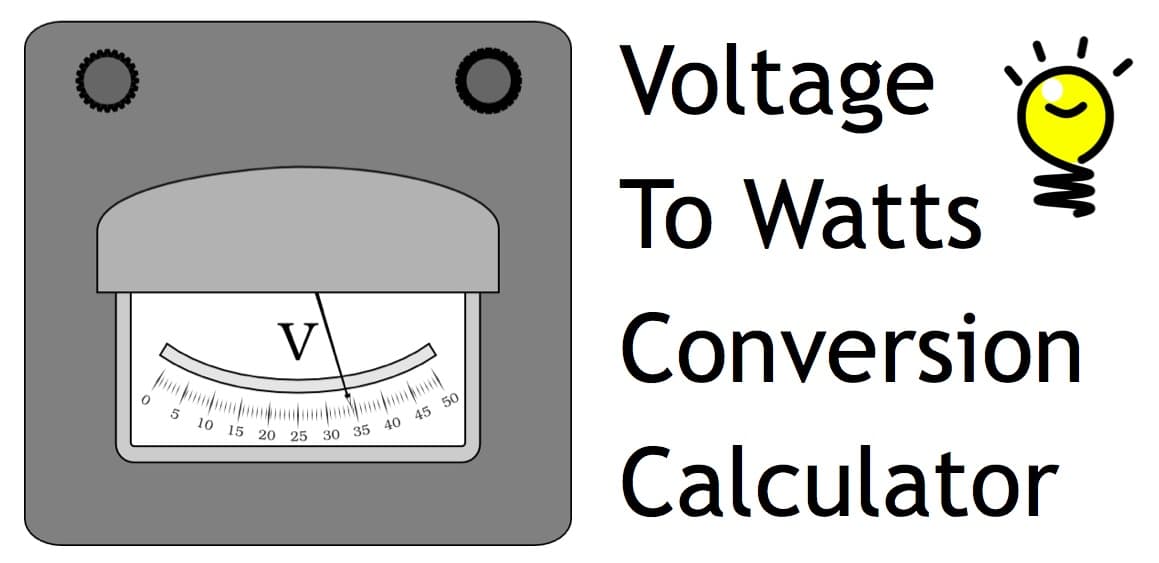Volts to Watts, Watts to Amps, Volts to Amps Conversion Calculator
Our online watts calculator / conversion tool can convert watts to amps, volts to watts, and volts to amps. The calculator works by filling in any of two of the three fields (volts amps watts) to calculate the value of the third field. This tool can convert any value as long as you enter the two other values.
Convert Volts to Watts / Calculate |
|
| Voltage: | |
| Watts: | |
| Amps: | |
Example Conversions
Example 1: To convert volts to amps for a 24V VA50 power supply, enter 24 volts and 50 Watts. Click Calculate.
Example 2: To convert watts to amps for a 12V DC 500mA power supply, enter 12 volts and .5 amps. Click Calculate.
Example 3: To determine the power output a solar generator produce, if you have a 100W solar panel and need to know the amps it generates at 12V, enter 100 watts and 12 volts. Click Calculate.
Understanding Volts and Watts
Volts and watts are two fundamental concepts in electrical energy that play a crucial role in the functioning of electrical systems. Volts measure the electrical potential difference between two points in an electric circuit, essentially representing the “pressure” that drives electric current through the circuit. On the other hand, watts measure the rate at which electrical energy is being used or consumed. Understanding the relationship between volts and watts is essential for converting volts to watts and making informed decisions about electrical systems. By grasping these concepts, you can better manage and optimize the performance of your electrical devices and systems.
Voltage, Watts, Amps Relationship
Understanding the relationship between volts, watts, and amps is crucial for anyone dealing with electrical devices. Knowing how much power is needed for various electrical devices is essential to ensure efficient energy use and avoid overloading systems. This knowledge helps in selecting the right devices, such as solar generators, and ensures they operate safely and effectively.
To convert volts to watts, you need to know the current in amps. The formula is simple: Watts = Volts x Amps. For example, if you have a device that operates at 120 volts and uses 2 amps, it will consume 240 watts of power.
Frequently Asked Questions (FAQ)
- How do you convert volts to watts?
The formula to convert voltage to watts is watts = amps x volts. - How do you convert watts to amps?
The formula to convert watts to amps at a fixed voltage is amps = watts / volts. - How do you convert volts to amps?
The formula to convert volts to amps at a fixed wattage is: amps = watts / volts. - How do you convert amps to watts?
The formula to convert amps to watts at a fixed voltage is: watts = amps x volts. - How is volts to watts conversion useful for selecting solar generators? Understanding the conversion of volts to watts is crucial when selecting solar generators. It helps in determining the right generator for specific power needs, such as off-grid living or backup power sources. Knowing the electrical ratings ensures that the solar generator can efficiently power home appliances and other devices.
Converting Volts to Watts
Converting volts to watts is a straightforward process that requires knowledge of the voltage and current in amps. The formula to convert volts to watts is P(W) = V(V) × I(A), where P is power in watts, V is voltage in volts, and I is current in amps. This formula is applicable for both DC and AC circuits. For example, if you want to convert 12 volts to watts for a DC circuit with 2 amps of current, the calculation would be P(W) = 12 V × 2 A = 24 watts. By using this simple formula, you can easily determine the power consumption of your electrical devices and ensure that your electrical systems are designed to handle the required load.
Convert Watts to Amps (Detailed Example)
Here is one example of how this calculator is commonly used by security system installers as an amp calculator. The installer needs to calculate the distance that a power cable can be run from a security camera DVR to a CCTV camera, HD security camera, and even one of the latest UHD 4K security cameras. They first need to calculate how many amps a 24V AC power supply outputs. Typically, 24V AC power supplies have VA (voltage amps) ratings and not amps. For example a 24VAC50 power supply is 24 volt, 50 volt-amps (watts are also known as volt-amps). In the above calculator, the installer will enter a value of 24 in the volts field and a value of 50 in the watts field.
Importance of Conversion in Electrical Systems
Converting volts to watts is essential in electrical systems, particularly in solar power systems. Solar panels produce electricity in the form of direct current (DC), which needs to be converted to alternating current (AC) for use in homes and businesses. Understanding the relationship between volts and watts helps solar panel installers and users determine the correct size of the solar panel system and the inverter required to convert DC power to AC power. This knowledge ensures that the solar power system is efficient and capable of meeting the energy demands of the household or business.
Electrical Term Definitions
Here are some useful electrical terms related to calculating volts to watts, watts to amps, and volts to amps.
- Volt – unit of measure of the electrical force or pressure which causes an electricity current to flow in a circuit. One volt is the amount of pressure required to cause one ampere of current to flow against one ohm of resistance. The concept is similar to water pressure.
- Watt – unit of measure of the electrical power applied in a circuit. Watts are also known as volt-amps and are a unit of electrical measurement typically used in AC power circuits. Watts are calculated by multiplying the current (measured in amps) by the electrical pressure (measured in volts).
- Amp (Ampere) – unit of measure of the flow rate of current in an electrical circuit. One amp is the amount of current when one volt of electrical pressure is applied against one ohm of resistance. Amps are used to measure electricity flow similarly to how GPM (gallons per minute) are used to measure the volume of water flowing.
- Ohm – unit for measuring the resistance of flow in an electrical current. Electrical conductors (such as a wire) apply resistance to the flow of current. This is similar to how a tube or hose applies resistance to the flow of water. One ohm is the amount of resistance that limits current flow to one amp in a circuit with one volt of electrical pressure.
- Ohm’s Law – Ohm’s Law states that when electric current flows through a conductor (such as a cable), the intensity of the current (amps) equals the electromotive force (volts) driving it, divided by the resistance of the conductor.
Electrical System Considerations
When designing or installing an electrical system, it’s essential to consider the power consumption of electrical devices and the power output of the solar generator or portable power station. Converting volts to watts helps determine the correct size of the wiring and electrical system required to handle the power output. Additionally, understanding the relationship between volts and watts helps identify potential electrical safety hazards and ensures that the electrical system is designed and installed to meet safety standards. By taking these factors into account, you can create a reliable and efficient electrical system that meets your energy needs.
Conclusion
In conclusion, understanding the relationship between volts and watts is crucial for converting volts to watts and making informed decisions about electrical systems. Converting volts to watts is a straightforward process that requires knowledge of the voltage and current in amps. The importance of conversion in electrical systems cannot be overstated, particularly in solar power systems. By considering the power consumption of electrical devices and the power output of the solar generator or portable power station, electrical system designers and installers can ensure that the electrical system is designed and installed to meet safety standards and optimize power output.
Online Tools & Calculators
Please visit our Calculators, Converters, and Tools page for additional online applications.
About This Tool
This online calculator was created by Mike Haldas for CCTV Camera Pros. CCTV Camera Pros is a direct supplier of video surveillance equipment for home, business, and government. If you have any questions about this tool or anything related to security camera systems, please contact Mike at mike@cctvcamerapros.net







